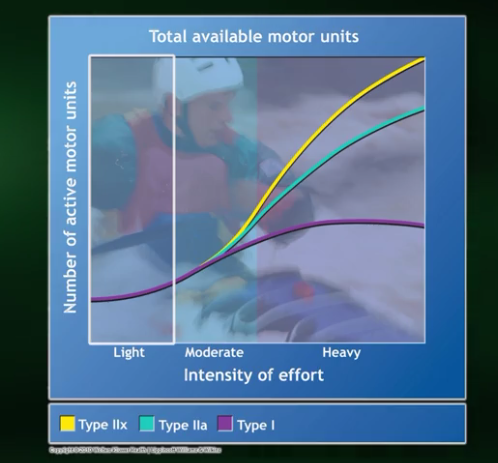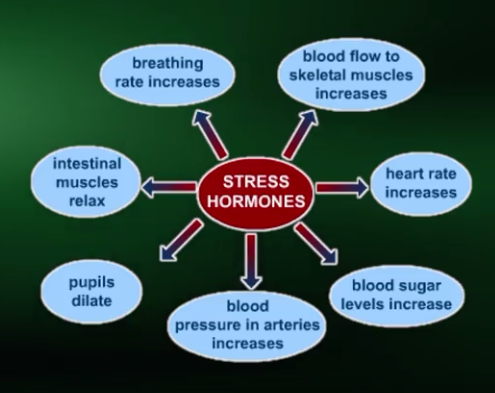Week 2 Science Of Exercise

Types of muscle systems
- Skeletal
- Cardiac/Heart.
- Smooth - muscles surrounding blood vessels.
Skeletal muscles
- Types of contractions
- Isometric - no change in length.
- Planking.
- Concentric - muscle shortens.
- Curls, presses. Most common form of contraction.
- Eccentric - muscle lengthens.
- Downhill running
- Isometric - no change in length.
- Contractions cause muscle soreness.
- Consists of 3 types of fibers.
- Type I fibers - high in mitochondria, can use fats aerobically, so slow to fatigue and hence important for endurance.
- Type IIx fibers - Use anaerobic paths to generate energy. Very fast, so required in exercises where you need lot of force, very quickly, for short durations.
- Type IIa fibers - Mixture of properties from type IIx and type I.
- Average person have 50-50% of type I and type II fibers.

Respiratory systems
- Roles of respiratory systems
- Oxygen supply is maintained.
- Eliminate CO2 from the system.
- Buffering metabolic acids used during exercise.
- 98.5% of oxygen is carried by hemoglobin (red blood cells).
- Drop in pH and increase in body temperature, causes more oxygen to be unloaded into muscles. Warmup is important.
- Endurance training will lead to increase in red blood cells count.
- During exercise, ATP production leads to increase demand for oxygen, leading to increased quantity of CO2.
- Ventilatory rate - process of moving air into and out of the lungs.
- Affected by breathing frequency.
- Tidal volume. - It is better, as it provides more time to complete gas exchange.
- Valsalva maneuver - Grunting during exercise forces blood supply to heart to drop, forcing heart to pump more blood. But can lead to fainting or dizziness.
Cardiovascular systems
Cardiac Output = Heart Rate * Stroke Volume
- Increase in output of heart, enhancing delivery of oxygen and blood flow.
- Heart rate increases during exercise due to nervous systems and hormone (epinephrine), depends also on intensity of the exercise.
- Oxygen consumption is depended on cardiac output, amount of oxygen utilized in muscle cells for ATP production.
- Oxygen consumption increases with intensity of exercise, before plateauing to peak rate.
- Blood flow can increased by
- Increasing cardiac output.
- Blood vessels expand.
- Blood flow to muscles unused in exercise is reduced - kidneys, stomach, liver.
- Oxygen levels drop as it is used for energy production, CO2 and hydrogen levels increases as output of energy production. This leads local smooth muscles to relax and increase blood flow.
Adaptations in Cardiovascular systems
- Lower resting heart rate.
- Greater stroke volume at resting.
- Lower heart rate during less intense exercise.
- Greater maximal cardiac output.
- High oxygen consumption at local muscles.
- Maximal heart rate is not affected by exercise.
- Training over a significant duration will cause
- Higher red blood cell count.
- Higher capillaries in muscle fiber.
- Higher mitochondria.
Endocrine systems
- Endocrine systems - glands which produce hormones.
- Pancreas - insulin
- Adrenal - epinephrine
- Pituitary gland - growth hormone.
- hormones - trace substances, carried via blood, regulate physiological and metabolic functions.
- Play important role in maintain homeostasis.
- Insulin - when blood glucose levels increase, help in consuming increased glucose.
- Type 2 diabetes is caused by insulin resistance. Regular exercise is affecting alleviating insulin resistance.
- Epinephrine - aka adrenaline (stress hormones)
- Released from adrenal glands.
- Lot of adrenaline is released during exercise due to stimulation from sympathetic nervous system.
- Similar to flight or fight response.
- Growth hormones
- Produced by Pituitary glands.
- Increases consumption of fatty acids.
- Help protein synthesis just after exercise as levels stay up for 1 hour after exercise.

Immune systems
Open Window Theory - After exercise, immune system is suppressed for few hours and hence more susceptible to viral or bacterial infections.
- Length of suppressed time is dependent on intensity and length of exercise.
- Even you are sick and symptoms are above neck (like cold), okay to do light exercise. Else rest.
- Regular moderate training will enhances immune systems but regular high intensity exercise will make immune system weak and highly susceptible to viral and bacterial infections.
- Regular exercise help to fight stress.